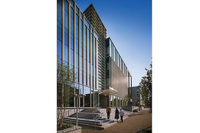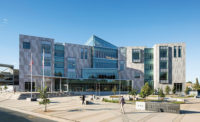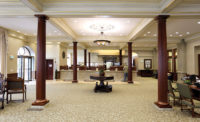The National Academy of Sciences in Washington, DC, enlisted the help of Quinn Evans Architects to provide new stone flooring that complemented and enhanced the existing stonework found in this 1927 historic building. The flooring was provided in the major circulation spaces — which included large enclosed courtyards and very wide corridors — accents around the perimeter of carpeted conference rooms, bases of walls in both stone flooring and carpeted areas, and placed in areas where original stone had been removed.
Several different stones were used to achieve this goal. Vermont Verde Antique marble from Vermont Verde Antique International and Unfading Green slate from Vermont Structural Slate were used as new flooring in multiple locations and to restore the flooring in the East Gallery. The Vermont Verde Antique — which is referred to as a marble, but is technically a serpentine — was selected to match the existing stone from additions completed during the 1960s.
Meanwhile, Unfading Green slate and Verde Andeer quartzite — supplied by Stone Source of Washington, DC — were used in the North Court and West Corridor as well as for the elevator lobby between the East Gallery and East Corridor. At the North Court, where there is a glass floor down the center of the space, the wall on the right is the original 1960s auditorium addition, which was completed with Imperial Danby marble from Vermont. The thresholds are Golden Wheat marble, similar to the use of yellow marble for thresholds in the historic part of the building.
According to Thomas Jester and Katie Irwin of Quinn Evans Architects, the primary reason the stones were selected was to match the color and texture of the existing materials used in the original building’s Great Hall as well as within the existing galleries. The Great Hall features a field of Pennsylvania Bluestone, accented with bands of Unfading Green slate and Utah Bird’s Eye marble, a yellow/gold material. The Great Hall’s original, historic columns are Vermont Verde Antique with American Cream Lens stone. Within the existing galleries, the floors have an existing field of Unfading Green slate, accented with black slate around the perimeter.
Sourcing the stone
Jester estimated using approximately 5,000 square feet of new stone flooring and 900 lineal feet of new stone base throughout the renovation. The majority of the stone used features a honed finish, although the Unfading Green slate used in the West Court has a cleft finish to provide more of an “outdoor feeling” within the space. This room also features a wall of the original South Dover marble from New York, which was installed in 1927.
The architect explained that some research went into selecting specific materials to match the existing color palette. “We found stone to match existing and then looked at a variety of green stones available at Stone Source here in D.C.,” Irwin said. “Ultimately, Verde Andeer quartzite was chosen as the new stone to bring in to complement the Unfading Green slate and give some variety. We looked at the available colors of Vermont slate from Vermont Structural Slate, but ultimately decided to stick with Unfading Green and not introduce the mottled, purple or red colors. The owner of the Vermont Verde Antique quarry also came and walked around the building with me. We looked at the wings that were added in the 1960s where the architects installed Vermont Verde Antique. Two colors were installed — a very brecciated medium green and a very dark green. In our project, we were removing some areas of this stone and reinstalling or providing new stone in adjacent areas.”
Where carpets were used on the interior, colors were chosen to complement the blue-green hues. New signage colors matched the Unfading Green slate, and colors of new wood paneling and paint colors were all coordinated with the stone.
Installation details
As expected, the design team faced challenges along the way. Their biggest hurdle was coordination of the joint locations. “The challenges were overcome with careful review of the shop drawings and close coordination with the construction manager and installers for mock-ups and to address field conditions,” Jester and Irwin said.
Bob Goldstein at Atlantic Refin-ishing & Restoration, Inc., as well as approximately 15 other workers, used the thinset technique to install the stone on the walls and floors, using Mapei Kerabond Keralastic. This method was chosen based on the thickness of the stone and substrate involved. The installation portion of the job was completed over a period of several months.
Ultimately, all of the planning and hard work paid off. The client was extremely happy with the results, and the project has won several awards, including the District of Columbia’s State Historic Preservation Officer’s Award in 2013.
|
National Academy of Sciences Renovation Washington, DC |
|
Architect: Quinn Evans Architects, Washington, DC Construction Manager: Gilbane Co. Stone Suppliers: Vermont Verde International, Rochester, VT (Vermont Verde Antique); Vermont Structural Slate, Fair Haven, VT (Unfading Green slate); Stone Source, Washington, DC (Verde Andeer quartzite and Golden Wheat marble) Stone Installer: Atlantic Refinishing & Restoration, Inc., Waldorf, MD |







